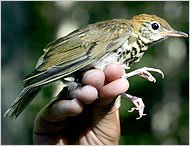 A study of songbirds in upstate New York has revealed very high levels of mercury in 178 species, with the highest levels being in wood thrushes.
A study of songbirds in upstate New York has revealed very high levels of mercury in 178 species, with the highest levels being in wood thrushes.The presence of mercury in lakes and streams is already well documented, and the New York Department of Health advises people to restrict the consumption of any freshwater fish caught in most of the state to no more than one meal a week.
But Dr. Evers is one of the first scientists to test for wildlife mercury contamination beyond fish. He began his work in this area in 1998 and found that common loons, which eat fish, had highly elevated levels of mercury that made them lethargic and caused their reproductive rates to drop.
He then decided to study songbirds, which never eat fish. In particular, he wanted to study the wood thrush, a small bird with a distinctive song that was once common throughout the Northeast. The population of wood thrushes has declined 45 percent in recent decades.
It was once thought that destruction of the bird’s forest habitat was responsible for the decline. But Dr. Evers now suspects that mercury contamination might be a factor, along with the wide-ranging negative effects of acid rain on the forests....Dr. Evers’s work suggests that when mercury falls on land, it is absorbed by soil and by fallen leaves that are consumed by worms and insects. Songbirds then feed on the bugs, absorbing the mercury.
While all the birds he tested last year had mercury in their blood, wood thrushes had the most, Dr. Evers said, an average of 0.1 parts per million. That is below the federal safe standard for fish (0.3 p.p.m.) but high enough to affect the birds’ reproductive cycle.
With fewer songbirds to eat potentially harmful insects, the state’s forests would be at greater risk for damage by gypsy moths and other pests, Dr. Evers said.
Beyond that, mercury leaching into soil could find its way into the food chain in ways that are still unknown, he said.

No comments:
Post a Comment